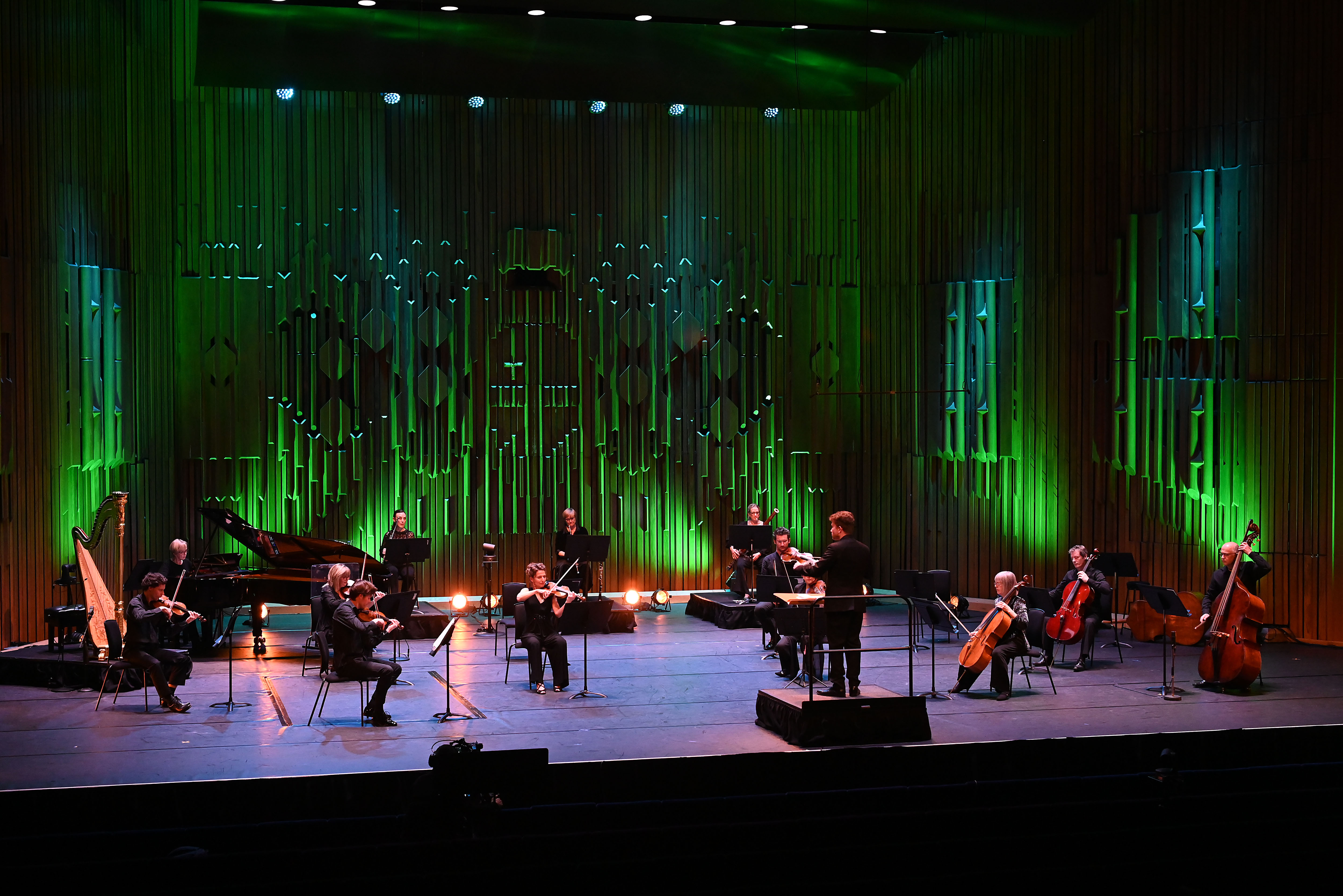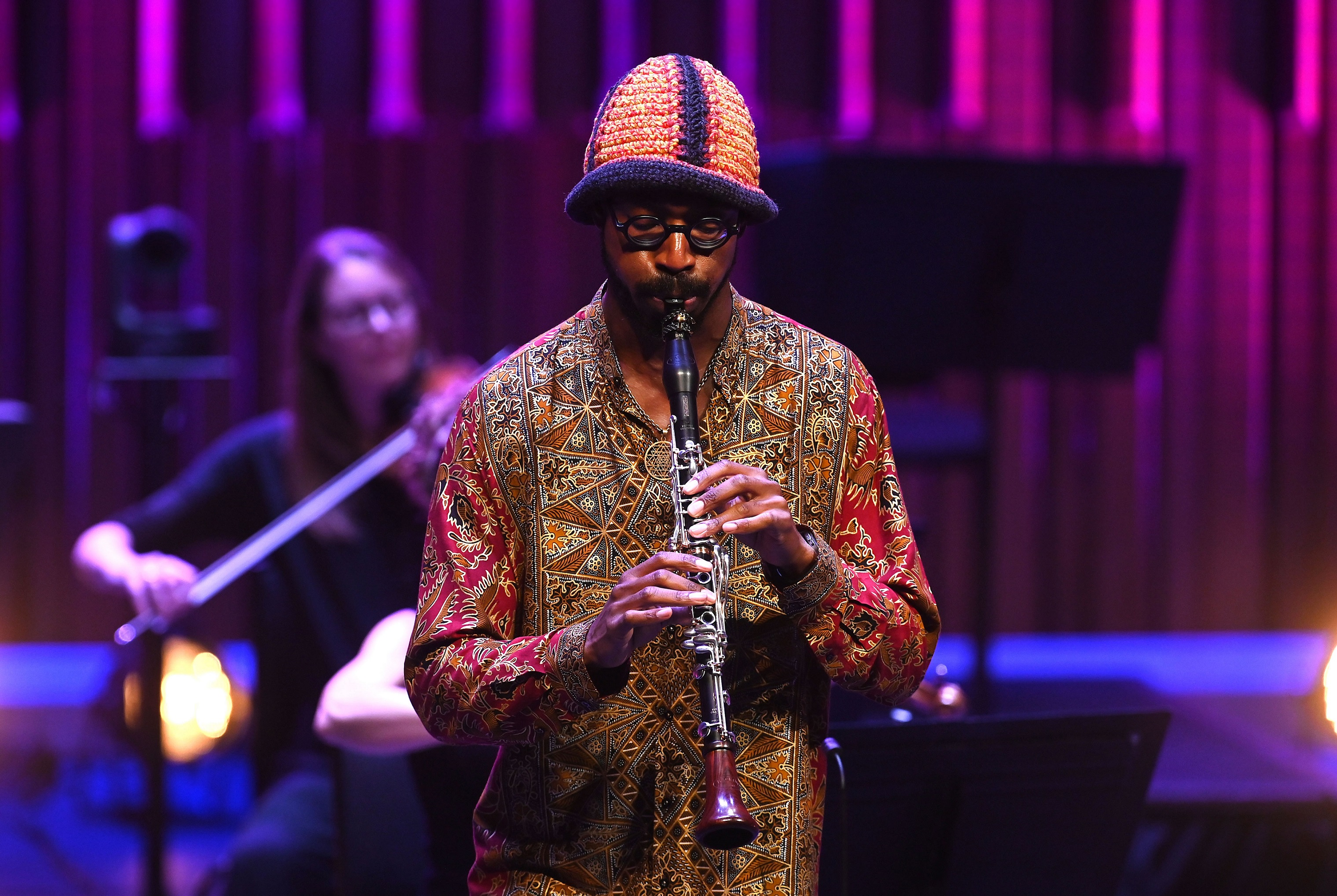Hutchings, Britten Sinfonia, Paterson, Barbican online review – saluting an American classic | reviews, news & interviews
Hutchings, Britten Sinfonia, Paterson, Barbican online review – saluting an American classic
Hutchings, Britten Sinfonia, Paterson, Barbican online review – saluting an American classic
Clarinet works by Copland and Stravinsky take centre stage at EFG London Jazz Festival
When Aaron Copland wrote his most beloved work, Appalachian Spring, in 1943/44, he gave it the unfussy working title of “Ballet for Martha” – Martha being the choreographer Martha Graham, for whom he’d written the score. It was only shortly before the premiere, long after the ink was dry on the score, that Graham appended the more alluring title, excerpted from Hart Crane’s poem "The Dance", by which the work is now known.
Scheduled as part of the Barbican’s Live from the Barbican series, as evidenced by last night’s performance by the Britten Sinfonia – in its original scoring for an ensemble of 13 instruments – what is incontrovertible is the communicative power of Copland’s music. Expertly conducted by Geoffrey Paterson, and brilliantly led by violinist Thomas Gould, the scintillating, edge-of-your-seat playing would surely convince even the most immovable naysayer that this was Copland’s finest score, vibrating as it does between a contemplative immobility and a compelling rhythmic drive (Britten Sinfonia pictured below).
One of the prime movers in the UK’s flourishing jazz scene, clarinettist, saxophonist and composer Shabaka Hutchings (Sons of Kemet, The Comet is Coming, Shabaka and the Ancestors) took to the Barbican stage to perform Igor Stravinsky’s Three Pieces for Solo Clarinet, composed in 1919. Hutchings shaped the first movement’s metrical asymmetry with great care, its liberal use of acciaccaturas and chromatic descending motif at times recalling the introduction of The Rite of Spring. Written entirely without bar lines or time signature, Hutchings made an impressive fist of the rapid-fire arpeggios and vertiginous registral leaps of the second movement, although the very opening phrase suggested that the notes weren’t entirely secure under his fingers. With its overt nods to the ‘Ragtime’ from The Soldier’s Tale, Hutchings handled the constant metrical shifts and breathlessness of the third movement with real conviction.
The six-minute clarinet improvisation which followed featured an extraordinary central section consisting of one unbroken melodic arc – with Hutchings, through the use of circular breathing, sustaining a single phrase for three minutes which at times created the impression of two-part counterpoint. The applause from the Britten Sinfonia players at its conclusion seemed entirely spontaneous (Shabaka Hutchings pictured below).
Cast in two movements connected by an extended cadenza, Hutchings and the Britten Sinfonia captured the 3/4 lilt of the opening movement, its absolute clarity of construction, and its profound melodicism to perfection, with the homogeneity of the string textures bathing the soloist in a warm glow.
Rather than recapitulating material heard in the first movement, the cadenza introduced themes which would be explored in the rhythmically charged second movement, the motoric rhythms of which sounded like the inner workings of some giant clock – with the addition of the exceptional pianist Catherine Edwards creating an even greater percussive bite. Despite some wobbly moments in the solo part during the faster passagework at the extremes of the clarinet’s register, the urgency of the pulse was undeniable, with the movement’s free rondo form referencing everything from Charleston rhythms to Brazilian folk song, all brought to a dramatic close by the soloist’s final glissando – a loving nod to Gershwin’s Rhapsody in Blue.
rating
Explore topics
Share this article
The future of Arts Journalism
You can stop theartsdesk.com closing!
We urgently need financing to survive. Our fundraising drive has thus far raised £49,000 but we need to reach £100,000 or we will be forced to close. Please contribute here: https://gofund.me/c3f6033d
And if you can forward this information to anyone who might assist, we’d be grateful.

Subscribe to theartsdesk.com
Thank you for continuing to read our work on theartsdesk.com. For unlimited access to every article in its entirety, including our archive of more than 15,000 pieces, we're asking for £5 per month or £40 per year. We feel it's a very good deal, and hope you do too.
To take a subscription now simply click here.
And if you're looking for that extra gift for a friend or family member, why not treat them to a theartsdesk.com gift subscription?
more Classical music
 Hallé John Adams festival, Bridgewater Hall / RNCM, Manchester review - standing ovations for today's music
From 1980 to 2025 with the West Coast’s pied piper and his eager following
Hallé John Adams festival, Bridgewater Hall / RNCM, Manchester review - standing ovations for today's music
From 1980 to 2025 with the West Coast’s pied piper and his eager following
 Kaploukhii, Greenwich Chamber Orchestra, Cutts, St James's Piccadilly review - promising young pianist
A robust and assertive Beethoven concerto suggests a player to follow
Kaploukhii, Greenwich Chamber Orchestra, Cutts, St James's Piccadilly review - promising young pianist
A robust and assertive Beethoven concerto suggests a player to follow
 Robin Holloway: Music's Odyssey review - lessons in composition
Broad and idiosyncratic survey of classical music is insightful but slightly indigestible
Robin Holloway: Music's Odyssey review - lessons in composition
Broad and idiosyncratic survey of classical music is insightful but slightly indigestible
 Classical CDs: Wolf-pelts, clowns and social realism
British ballet scores, 19th century cello works and contemporary piano etudes
Classical CDs: Wolf-pelts, clowns and social realism
British ballet scores, 19th century cello works and contemporary piano etudes
 Bizet in 150th anniversary year: rich and rare French offerings from Palazzetto Bru Zane
Specialists in French romantic music unveil a treasure trove both live and on disc
Bizet in 150th anniversary year: rich and rare French offerings from Palazzetto Bru Zane
Specialists in French romantic music unveil a treasure trove both live and on disc
 Scottish Chamber Orchestra, Ibragimova, Queen’s Hall, Edinburgh review - rarities, novelties and drumrolls
A pity the SCO didn't pick a better showcase for a shining guest artist
Scottish Chamber Orchestra, Ibragimova, Queen’s Hall, Edinburgh review - rarities, novelties and drumrolls
A pity the SCO didn't pick a better showcase for a shining guest artist
 Kilsby, Parkes, Sinfonia of London, Wilson, Barbican review - string things zing and sing in expert hands
British masterpieces for strings plus other-worldly tenor and horn - and a muscular rarity
Kilsby, Parkes, Sinfonia of London, Wilson, Barbican review - string things zing and sing in expert hands
British masterpieces for strings plus other-worldly tenor and horn - and a muscular rarity
 From Historical to Hip-Hop, Classically Black Music Festival, Kings Place review - a cluster of impressive stars for the future
From quasi-Mozartian elegance to the gritty humour of a kitchen inspection
From Historical to Hip-Hop, Classically Black Music Festival, Kings Place review - a cluster of impressive stars for the future
From quasi-Mozartian elegance to the gritty humour of a kitchen inspection
 Shibe, LSO, Adès, Barbican review - gaudy and glorious new music alongside serene Sibelius
Adès’s passion makes persuasive case for the music he loves, both new and old
Shibe, LSO, Adès, Barbican review - gaudy and glorious new music alongside serene Sibelius
Adès’s passion makes persuasive case for the music he loves, both new and old
 Anja Mittermüller, Richard Fu, Wigmore Hall review - a glorious hall debut
The Austrian mezzo shines - at the age of 22
Anja Mittermüller, Richard Fu, Wigmore Hall review - a glorious hall debut
The Austrian mezzo shines - at the age of 22
 First Person: clarinettist Oliver Pashley on the new horizons of The Hermes Experiment's latest album
Compositions by members of this unusual quartet feature for the first time
First Person: clarinettist Oliver Pashley on the new horizons of The Hermes Experiment's latest album
Compositions by members of this unusual quartet feature for the first time

Add comment